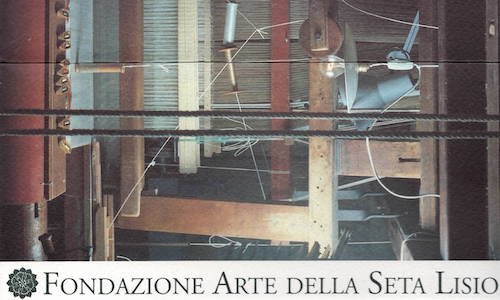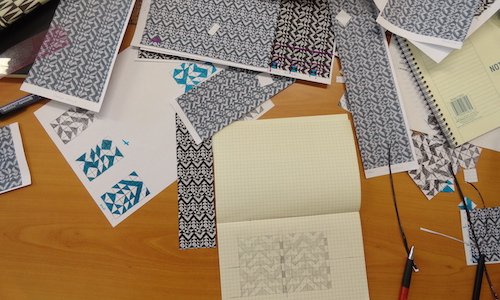Silk Weaving in Florence
During my three years studying under Barbara Setsu Pickett in the early 1990’s I heard many stories of her experiences living and traveling in Italy while studying silk velvet weaving at the Lisio Foundation in Florence. It was a dream of mine to join her on one of the biannual trips that she took students on through the University of Oregon.
One trip after another slipped by me as various obligations prevented me from being able to attend this class. Finally in 2014 everything in my life aligned so that I could join in on this trip to Italy and study silk weaving on the jacquard looms at Lisio.
After a couple long flights, a couple bus rides through Florence and across the Arno river, and trying to interpret directions while lugging my suitcase, I finally arrived at the gates of the Lisio Foundation - one depicting spinning and one depicting weaving.
There were seven of us there as students, with Barbara as our fearless leader. We all stayed in student apartments on the grounds of the foundation, and I shared one of the apartments with three of the college students. We cooked many of our own meals, but also enjoyed frequent outings to enjoy the local cuisine and gelato.
The looms at Lisio that we would be weaving on were not today’s state-of-the-art jacquards controlled by computer software, but 19th century jacquards requiring the punching and sewing of hundreds of cards. Barbara had a special velvet loom set up to weave a project she had already designed as a tribute to Vittorio, her maestro, who had passed on earlier in the year.
During our three-week course at Lisio we studied under master weaver Eva Basile. First we studied examples of textiles that had been woven at Lisio, analyzing them by looking through magnifying glasses and learning about their weave structures.
There were three looms set up for our class, already warped in very fine white silk at 145 ends per inch. We divided into three teams and I joined up with Heather and June to begin creating a design for the lampas loom we would be working on. Since I enjoy exploring symmetry patterns and one of my favorite motifs is the half-square triangle, I suggested that we experiment with that.
After exploring a number of possible arrnagements of this motif we settled on a design that we were happy with and transferred it onto point paper. Although our warp was only eight inches wide, the design on point paper was greatly enlarged so that we could work from it and read how each thread would be weaving in order to punch the cards.
Working the card-punching machine was something like something like sitting at a piano with just eight keys. In fact, we were told that people with a background in piano tended to make the best card punchers, and the process felt very natural to me. Each line on the point paper tells you which keys needed to be depressed for each row on the strip of cardboard. A card is aligned to feed through the machine, you depress the keys for the shafts you want lifted in a particular row, and then (as my vague memory recalls) you step on a pedal that causes the machine to punch the holes. And then continue on to the next row on the card.
Barbara punching cards for her design with Vittorio’s signature
The three of us in my group took turns punching cards, a total of 208 cards which had to be kept in perfect order. We then went to the machine that stitched them together into a continuous strip. You had to keep a close eye on this process, as the cards needed to be fed onto the machine at the right pace and the cards occasionally got jammed up (it made me think of Lucy working on the conveyor belt at the chocolate factory).
Barbara feeding cards into the stitching machine
The two ends of the long string of cards needed to be hand-sewn together to form a continuous loop.
Eva demonstrating how to stitch the two end cards together
And finally the continuous loop of cards was assembled onto the jacquard mechanism at the top of the loom and we were ready to begin weaving.
By this time we only had three days left of our course to be at the loom. My group of three worked out a schedule to divide each day into three 3-hour shifts. It was exciting to finally sit and weave at the loom and watch the design emerge. There was a stash of colored silk threads that we were free to use as our weft, which enabled us to explore various colorways with our design.
There were plenty of frustrations along the way because the fine silk warp threads broke with some regularity, and it was very difficult to find them to make repairs. Occasionally the jacquard mechanism got jammed up, and Eva would have to climb up to the top of the loom to get it straightened out.
Despite the various stops and starts, we all were able to develop a rhythm in the weaving process and waited with bated breath to watch our cloth unroll from the loom at the end of the class.
Our cloth was cut apart into the sections that each of us wove. From our individual sections we got to choose a small strip to keep and other strips were donated to the Lisio archives, the University of Oregon archives, and a strip was given to each of the students who worked on the other two looms.
The grand finale of the class was seeing the velvet piece that Barbara wove while we were busy in class - a beautiful homage to Vittorio.
We had a little party at lunch on our last day with a special cake. Eva presented Barbara with a folio that had a small piece of velvet that had been woven by Vittorio mounted into it. It was a very touching moment, and I think a particularly bittersweet experience for Barbara.
All in all it was an amazing and intense experience, and a view into the world of weaving on 19th century jacquard looms. There were many other wonderful experiences during our time in Italy, and I will share some of those with you in my next blog post.

















